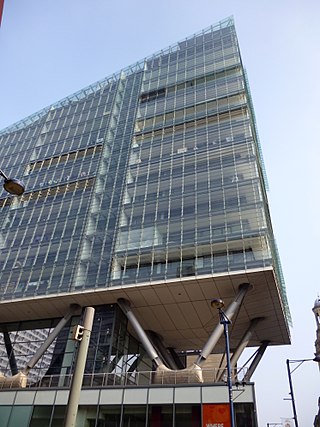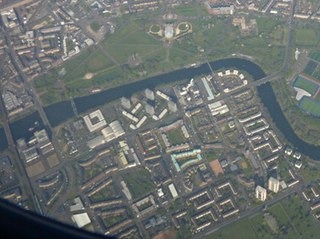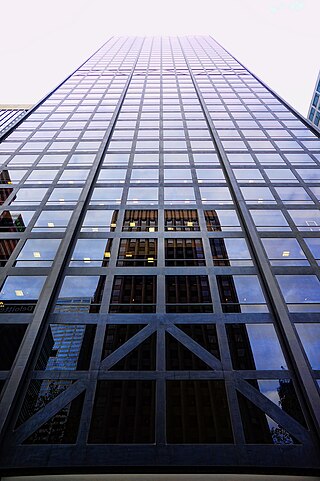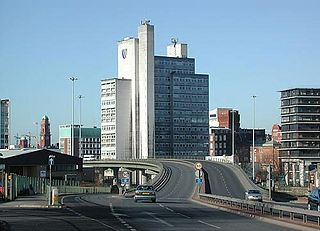
A tower block, high-rise, apartment tower, residential tower, apartment block, block of flats, or office tower is a tall building, as opposed to a low-rise building and is defined differently in terms of height depending on the jurisdiction. It is used as a residential, office building, or other functions including hotel, retail, or with multiple purposes combined. Residential high-rise buildings are also known in some varieties of English, such as British English, as tower blocks and may be referred to as MDUs, standing for multi-dwelling units. A very tall high-rise building is referred to as a skyscraper.
Brutalist architecture is an architectural style that emerged during the 1950s in the United Kingdom, among the reconstruction projects of the post-war era. Brutalist buildings are characterised by minimalist constructions that showcase the bare building materials and structural elements over decorative design. The style commonly makes use of exposed, unpainted concrete or brick, angular geometric shapes and a predominantly monochrome colour palette; other materials, such as steel, timber, and glass, are also featured.

Sunlight House is a Grade II listed building in the art deco style on Quay Street in Manchester, England. Completed in 1932 for Joseph Sunlight, at 14 storeys it was the tallest building in Manchester, and the top floors of turrets and multiple dormer windows and mansard roofs create a distinctive skyline.

No. 1 Deansgate is the name and location of a medium-rise apartment building in central Manchester, England. It is the tallest all-steel residential building in the United Kingdom, and one of the most expensive addresses in Manchester. The building was completed in 2002, and is situated at the north end of Deansgate close to Manchester Cathedral.

Hutchesontown is an inner-city area in Glasgow, Scotland. Mostly residential, it is situated directly south of the River Clyde and forms part of the wider historic Gorbals district, which is covered by the Southside Central ward under Glasgow City Council.

Beetham Tower is a 47-storey mixed use skyscraper in Manchester, England. Completed in 2006, it is named after its developers, the Beetham Organisation, and was designed by SimpsonHaugh and Partners. The development occupies a sliver of land at the top of Deansgate, hence its elongated plan, and was proposed in July 2003, with construction beginning a year later.

140 William Street is a 41-storey 152m tall steel, concrete and glass building located in the western end of the central business district of Melbourne, Victoria, Australia. Constructed between 1969 and 1972, BHP House was designed by the architectural practice Yuncken Freeman alongside engineers Irwinconsult, with heavy influence of contemporary skyscrapers in Chicago, Illinois. The local architects sought technical advice from Bangladeshi-American structural engineer Fazlur Rahman Khan, of renowned American architectural firm Skidmore, Owings & Merrill, spending ten weeks at its Chicago office in 1968. At the time, BHP House was known to be the tallest steel-framed building and the first office building in Australia to use a “total energy concept” – the generation of its own electricity using BHP natural gas. The name BHP House came from the building being the national headquarters of BHP. BHP House has been included in the Victorian Heritage Register for significance to the State of Victoria for following three reasons:

The Department of Mathematics at the University of Manchester is one of the largest unified mathematics departments in the United Kingdom, with over 90 academic staff and an undergraduate intake of roughly 400 students per year and approximately 200 postgraduate students in total. The School of Mathematics was formed in 2004 by the merger of the mathematics departments of University of Manchester Institute of Science and Technology (UMIST) and the Victoria University of Manchester (VUM). In July 2007 the department moved into a purpose-designed building─the first three floors of the Alan Turing Building─on Upper Brook Street. In a Faculty restructure in 2019 the School of Mathematics reverted to the Department of Mathematics. It is one of five Departments that make up the School of Natural Sciences, which together with the School of Engineering now constitutes the Faculty of Science and Engineering at Manchester.

The architecture of Manchester demonstrates a rich variety of architectural styles. The city is a product of the Industrial Revolution and is known as the first modern, industrial city. Manchester is noted for its warehouses, railway viaducts, cotton mills and canals – remnants of its past when the city produced and traded goods. Manchester has minimal Georgian or medieval architecture to speak of and consequently has a vast array of 19th and early 20th-century architecture styles; examples include Palazzo, Neo-Gothic, Venetian Gothic, Edwardian baroque, Art Nouveau, Art Deco and the Neo-Classical.

The Maths and Social Sciences Building is a high-rise tower in Manchester, England. It was part of the University of Manchester Institute of Science and Technology (UMIST) until that university merged with the Victoria University of Manchester, to form the University of Manchester, in 2004. It was vacated by the university in 2010 but is currently in use by the School of Materials while waiting for a new building to be constructed.

The Alan Turing Building, named after the mathematician and founder of computer science Alan Turing, is a building at the University of Manchester, in Manchester, England. It houses the School of Mathematics, the Photon Science Institute and the Jodrell Bank Centre for Astrophysics (JBCA). The building is located in the Chorlton-on-Medlock district of Manchester, on Upper Brook Street, and is adjacent to University Place and the Henry Royce Institute.

OUE Downtown or 6 Shenton Way, formerly DBS Building Towers is a high-rise skyscraper complex at 6 Shenton Way in the central business district of Singapore. Tower 1, at 201 metres (659 ft) and 50 storeys, was completed in 1975 and is one of Singapore's oldest skyscrapers. Tower 2, at 150 m (490 ft) and 36 storeys, was completed twenty years later in 1994. The former headquarters of DBS Bank was located in the complex. Overseas Union Enterprise (OUE) acquired the complex in 2010 and renamed it 'OUE Downtown'.

The Intercontinental Tower, Manchester is a cancelled landmark skyscraper that was proposed in Manchester city centre, England. The building would have been a five-star luxury hotel run by InterContinental Hotels Group, and developed by Northern Irish development firm, Benmore.

Frederick Romberg,, , was a Swiss-trained architect who migrated to Australia in 1938, and became a leading figure in the development of Modernism in his adopted city.

Brighton and Hove, a city on the English Channel coast in southeast England, has a large and diverse stock of buildings "unrivalled architecturally" among the country's seaside resorts. The urban area, designated a city in 2000, is made up of the formerly separate towns of Brighton and Hove, nearby villages such as Portslade, Patcham and Rottingdean, and 20th-century estates such as Moulsecoomb and Mile Oak. The conurbation was first united in 1997 as a unitary authority and has a population of about 253,000. About half of the 20,430-acre (8,270 ha) geographical area is classed as built up.

Bridgewater Heights is a skyscraper apartment building in Manchester, England, west of Oxford Street.

RMIT Building 8 is an educational building, part of RMIT University's City campus in Melbourne, Victoria. It is located at 383 Swanston Street, on the northern edge of Melbourne's central business district.

The Redfern Building is a Grade-II listed building which was completed in 1936 in Manchester, England. The building is situated on Dantzic Street and meets the junction of Mayes Street and Hanover Street. Redfern was originally built for office and warehouse use.
Edmund Charles "Ted" Percey was a British architect with Scherrer and Hicks and later a partner in that firm, who was responsible for the design of several notable concrete constructions for the English water industry as well as the brutalist Mathematics Tower for Manchester University.

The Kilburn Building is a building on the Oxford Road in Manchester which is home to the Department of Computer Science at the University of Manchester. The building was designed by the Building Design Partnership and completed in 1972, with three storeys in a square shape, measuring 76 by 76 metres. The building was formerly known as the Computer Building changing its name in 2001 in honour of Tom Kilburn who died in the same year.



















